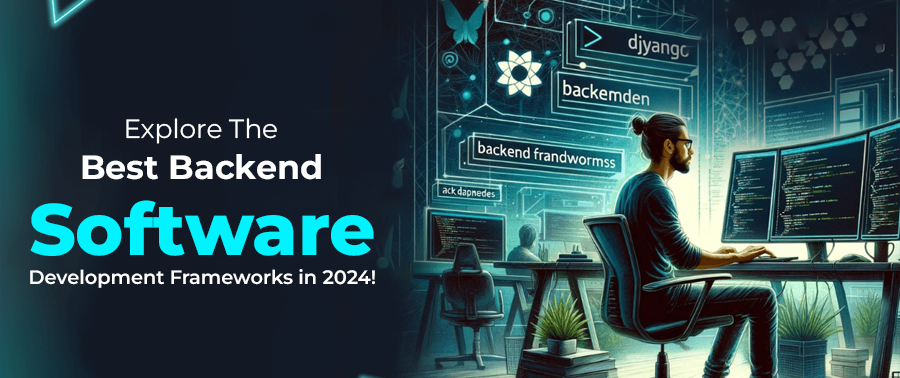As we step into 2024, the landscape of backend software development is evolving rapidly, driven by innovation and the need for robust, scalable solutions.
In this blog, we embark on a journey to discover the top backend software development frameworks that are poised to shape the tech landscape in 2024.
Understanding Software Development: A Crucial Foundation
The backend is essentially the server side of an application, responsible for managing databases, executing user requests, and ensuring the overall functionality of the software. It involves the development of server logic, databases, APIs, and other components that contribute to the seamless functioning of an application.
Types Of Software Development Frameworks
Frameworks for the Backend
Software development can be supported by server-side frameworks. These are also called backend web development frameworks, which offer essential functionalities. Django and Rails are two instances of this rapid development web platform.
Frameworks for Frontend
Client-side frameworks, also called front-end frameworks, offer templates and components in HTML, CSS, and JavaScript. It forms the basic framework for creating the front end of a website or application. These frameworks are widely used; Angular.js, React, and Bootstrap are a few examples.
Frameworks for Mobile Development
The greatest debugging tools, programming interfaces, and software development tools for creating source code compatible with a range of mobile devices are all provided by a mobile development framework. These frameworks include React Native and Flutter.
Why Frameworks Matter in Backend Development
A framework acts as the building block for developers, providing a structured foundation to streamline the development process. They come pre-equipped with libraries, tools, and conventions, allowing developers to focus on crafting unique features rather than reinventing the wheel.
Perks of Backend Frameworks-
Security: A framework provides security from multiple directions. The security of your application against external attacks and issues, as well as crashes, slowness, and other negative elements, may reduce its quality.
Scalability: Frameworks have a lot of adaptability. Assume, for instance, that you have selected the suitable backend framework for your undertaking. If so, you can keep using that framework to build your web application, starting with the simplest and working your way up to the most intricate.
Integrations: Because frameworks include pre-build tools, they make integrations simpler.
Top 10 Backend Software Development Frameworks in 2024
1. Django:
It is renowned for its simplicity and versatility. Django, a Python framework, remains a go-to choice for developers. Its "batteries-included" philosophy ensures a comprehensive set of tools for web development.
Its sophisticated security mechanisms that are enabled by default are one of its key benefits. Django is also incredibly scalable, which makes it a great option for developing web applications with various degrees of intricacy.
2. Express.js:
It is a lightweight and flexible Node.js framework. Express.js excels in building robust and scalable web applications. Its minimalist design allows developers the freedom to choose additional components as needed.
Thanks to its incorporation into well-known server-side stacks such as MERN, MEAN, and MEVN, Express.js has emerged as a crucial element in contemporary web development. It simplifies the development of reliable, scalable web applications with a broad range of features and functionalities.
3. Ruby on Rails:
Ruby on Rails simplifies development tasks and is well-preferred for convention over configuration approach. It promotes the use of best practices, enabling faster and more efficient development.
Features of this cutting-edge framework include seamless database table creation and migrations. For many developers looking to create unique platforms, e-commerce stores, SaaS development, and APIs, Rails is the favored option because of its object-oriented structure, emphasis on data protection, and tool integration.
4. Flask:
Flask, a micro-framework for Python, provides developers with the essentials to build web applications. It offers flexibility, making it an excellent choice for both beginners and experienced developers.
5. Spring Boot:
Based on the Java platform, Spring Boot facilitates the creation of stand-alone, production-grade Spring-based applications. Its emphasis on convention over configuration and ease of use make it a developer favorite.
6. Laravel:
Laravel, a PHP framework, is celebrated for its elegant syntax and developer-friendly features. It simplifies common tasks and offers powerful tools for tasks such as routing, caching, and authentication. Moreover, Laravel has built-in support for unit testing, so you can make sure your apps are always up to pace.
7. ASP.NET Core:
A cross-platform, high-performance framework by Microsoft, ASP.NET Core is designed for building modern, cloud-based, and internet-connected applications. Its modular architecture enhances flexibility. With code completion, multi-factor authentication, and web-page templating grammar, ASP.NET improves the fundamental characteristics of.NET.
Conversely, the earlier Windows-only ASP.NET versions have been completely redesigned as an open-source alternative called ASP.NET Core. For modern web and service development on Windows, Linux, macOS, or Docker, both software development frameworks are suitable.
8. Node.js
The Chrome V8 engine powers the strong software development framework Node.js. Its non-blocking I/O approach and event-driven, asynchronous design make it the perfect option for data-intensive applications that require real-time output delivery. Since its launch in 2009, Node.js has grown to be a crucial component of many business software programs. For their backend development requirements, well-known companies like GoDaddy, Netflix, LinkedIn, Walmart, Yahoo, and Groupon rely on Node.js.
9. FastAPI:
A modern, fast (high-performance), web framework for building APIs with Python 3.7+ based on standard Python type hints, FastAPI is gaining popularity for its speed and ease of use.
10. Vue.js:
Vue.js is a straightforward software development framework with a lot of capabilities. Its progressive structure allows for incremental adoption, which contributes to its simplicity as an MVC frontend framework. The main library for Vue.js concentrates just on the View layer of the MVC, making it simple to integrate with other libraries or projects to expand its capabilities. Vue.js is primarily used to construct user interfaces, but when paired with contemporary tooling and accompanying libraries, it can also be used to create complex Single-Page Applications.
Trends Shaping Backend Development in 2024
Serverless Architectures: The rise of serverless computing is influencing backend development, allowing developers to focus on writing code without the burden of managing infrastructure.
Microservices: Backend development is increasingly adopting a microservices architecture, enabling the creation of modular, independently deployable services that work together seamlessly.
Containerization: Technologies like Docker and Kubernetes continue to gain prominence, offering scalable and portable solutions for deploying, managing, and orchestrating backend services.
GraphQL Integration: GraphQL is emerging as a powerful alternative to traditional REST APIs, providing a more efficient and flexible approach to data fetching.
Real-time Functionality: The demand for real-time applications is pushing backend frameworks to incorporate features like WebSockets for instant communication between clients and servers.
Conclusion:
Crafting Tomorrow's Digital Foundations
In the software development industry, frameworks have been and will continue to be important actors. They are well-liked due to their numerous benefits and characteristics, which make them ideal for developing intricate and sophisticated applications.
The world of backend software development in 2024 is characterized by innovation, efficiency, and adaptability. The frameworks mentioned here are just a glimpse into the diverse toolbox available to developers as they shape the digital landscape of the future.
Whether you're a seasoned developer or just starting, staying abreast of these trends and frameworks is essential for building robust, scalable, and future-ready applications. Embrace the power of backend frameworks, and embark on a journey to craft tomorrow's digital foundations today.




Top comments (0)